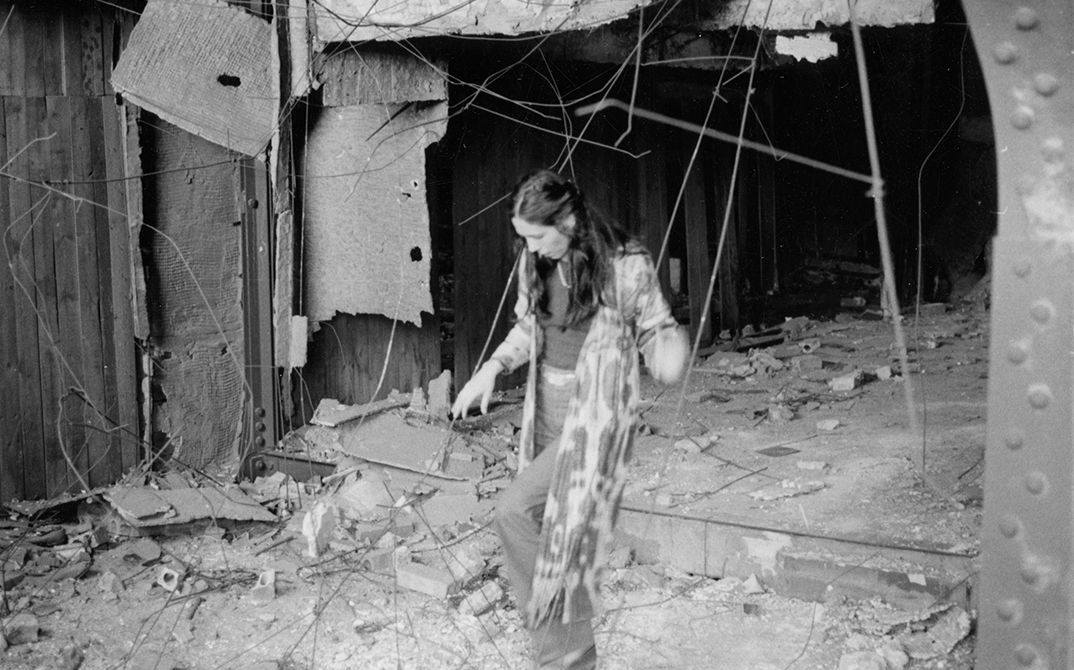I relocated to West Berlin in 1975 and shortly afterwards I moved into the spacious top floor of the almost empty Alte Deutsche Zentraldruckerei (literally the Old German Central Printing Press) near the Wall and Potsdamer Platz. The large windows and terrace overlooked the buildings that survived WWII like the Martin-Gropius-Bau or ruins like the Haus Vaterland, which were either later restored or demolished, empty spaces, new buildings and the Wall with its watchtowers, where guards viewed us through their binoculars as we cavorted on the terrace.
It was a strange and dramatic stage set for dreams, films, music, night wanderings, and contemplation of terrible destruction, terror, and loss. It was also the era of the RAF and the kidnapping of Schleyer. Neighbors must have reported us as suspicious and one morning I awoke as my door burst open and a policeman leveled his machine gun at me. The road I overlooked that passed between the empty spaces of Potsdamer Platz was often controlled by police, stopping and searching cars.
I spent much of my time walking around the neighborhood photographing and filming the façades of ruins and other buildings, following the Wall in either direction. The ruins of the Haus Vaterland were not even cordoned off and I climbed inside and up the broken stairs of what was once a “temple of amusement” or a “pleasure palace” and filmed with my Super 8 Nizo. At night I filmed the Reichstag, standing before the Wall, pitted with shrapnel and stained with soot. The words above its portal were bitterly ironic: Dem Deutschen Volke.
It was a strange and dramatic stage set for dreams, films, music, night wanderings, and contemplation of terrible destruction, terror, and loss.
This was the setting for self-reflection and personal observations, which conflicted with the almost daily reprimands by Berliners who seemed to me sour and authoritarian. I knew other German cities, not as well, but they seemed different. I could not have gone further from the islands in the Caribbean and South Seas where I grew up. Germany was the most extreme opposite: geographically, climate-wise, historically, and in temperament. Berlin was “the city of the bloody operetta” and the Cold War. Having made a film in Vanuatu STUDY OF AN ISLAND with Rudolf Thome, where a group of Europeans try to understand the lives of the islanders, I turned to study Berlin. BÖSE ZU SEIN IST AUCH EIN BEWEIS VON GEFÜHL (FURY IS A FEELING TOO) was originally intended as a feature, but faced opposition. Finally Jürgen Tomm of the SFB Berlin TV station (now RBB) offered me a sum and asked what I could do with it.
I collected conversations with friends and noted my daily conflicts. Heinz Emigholz was an inspiring collaborator on the texts. I blew up sections of my Super 8 films to 16mm on Helmut Herbst’s animation table in Hamburg. At some point Maurice Weddington came to see the rough cut and brought me his beautiful Fire in the Lake composition. The title was based on a consultation with the I Ching. It is Hexagram 49 and signifies: revolution, abolishing the old. “Simply put this hexagram describes a particular point in the cycle of life when peace has bubbled into chaos. Similar to what happens to water molecules that have begun to boil. There is conflict, there is ‘Fire in the Lake.’ When this boiling point, this chaos reaches a critical mass, there is radical change and a metamorphosis. There is a purging of the old and a rebirth and this is a revolution of the body, mind and spirit. These changes are mostly internal, unseen and quite possibly disbelieved until the change/metamorphosis is complete (think butterfly).” (https://fireinthelake.com/about/)
We laid the track of Fire in the Lake on the film and that was it—magical.
For me, BÖSE ZU SEIN IST AUCH EIN BEWEIS VON GEFÜHL was indeed “abolishing the old.” It was cathartic and liberating. The beginning of a new relationship to Berlin, one that continues to evolve and sometimes doubles back to questions raised in the late ‘70s and early ‘80s. Old threats are taking new forms.
Cynthia Beatt
